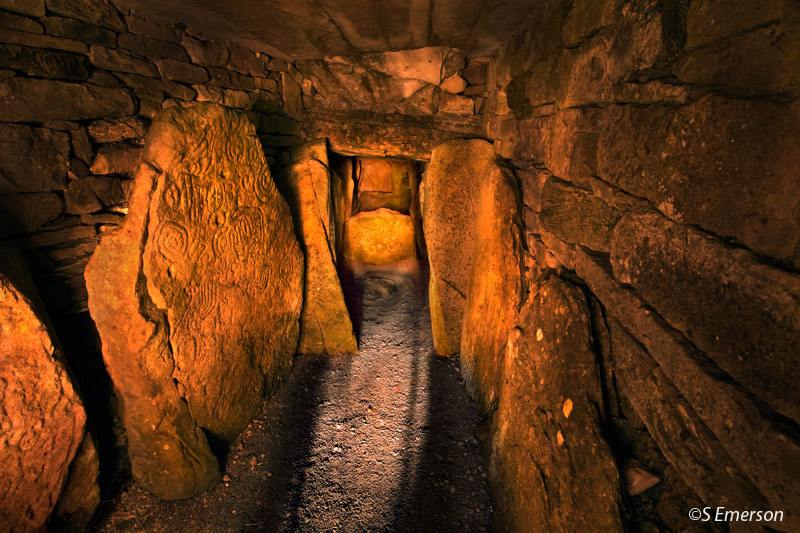Cracking the Newgrange Code - Martin Brennan - Page 2
 "Because
we have failed to comprehend what really happened in the Boyne
Valley we have missed out on thousands and thousands of years
of the development of human culture and science. Even in the
fact of a deliberate attempt made on the part of megalithic man
to outshine and preserve his knowledge and wisdom for all the
time, sealing it for future generations in an ingenious way,
we have failed to recognise it." Martin Brennan.
"Because
we have failed to comprehend what really happened in the Boyne
Valley we have missed out on thousands and thousands of years
of the development of human culture and science. Even in the
fact of a deliberate attempt made on the part of megalithic man
to outshine and preserve his knowledge and wisdom for all the
time, sealing it for future generations in an ingenious way,
we have failed to recognise it." Martin Brennan.
Finding the measurement system alone was an astounding discovery because it turns upside down every conventional theory about early Irish society. Far from the stone age Irish being savages, we are talking about a highly civilised people.
The new thinking also upsets world history. The development of civilisation is considered to have come much later in time, certainly not in Western Europe and definitely not during the Stone Age. William Stukely (1687-1765) had proposed a "Druid cubit", but although recognised as the finest field archaeologist of his period, his ideas in this area were dismissed. More recently, Professor Alexander Thom, after surveying stone circles for over thirty years, proposed the use of a megalithic yard. His ideas are just beginning to gain acceptance.
Peter Lancaster Brown, an astronomer and a critical self-confessed sceptic in the new field of astro-archaeology recently commented; "Perhaps still buried and preserved below the peat level is direct geometrical evidence of how the ancient Brits measured the sizes and shapes of their peculiar circles. Discovery of this kind of evidence might certainly tell us whether Alexander Thom's thesis is correct or false." Now this discovery has been made.
Since my initial discovery, I have been able to indisputably establish the Boyne Valley measuring system, and I found it to be consistent and precise according to the precision limits of the tools used. However, something even more astounding occurred when the measurements were closely examined by me back at the farmhouse. Over the next few days I made a series of discoveries that would produce a hitherto unimagined view of the level of scientific achievement and technology reached by at least 3,000 B.C. in Ireland.
The measurement system that I found in the Boyne Valley and also in the Loughcrew Mountains divides a line into parts A and B in such a way that the ration of length A to length B was the same as the ration of the entire line to A. In other words, the line was divided into what is known as a golden ratio. This is one of the most famous of all irrational numbers. The supposed inventors of this were the ancient Green mathematicians, who called it the "extreme and mean ratio".
The golden ratio has been widely thought to be the most pleasing way to divide a line. It obeys the same laws which govern the growth of many natural forms and the ratio has been widely used in art and architecture from the Greeks through the Renaissance and into modern architecture. To find its origins in the remote north-west fringes of the European continent during the Stone Age has implications that shake the foundations of every concept of the early history of Europe that has been current this century.
In order to measure the inscriptions, I decided to make a rod of brass which would have the A measurement on one side, and the B measurements on the other. When I did this, I noticed that my A notches and B notches met at just two points along the rod at 10A and 7B and at 20a and 14B. so I cut the rod at the 20A mark. Then it occurred to me that the originators of the measurements system would also be aware of these meeting points, and that therefore, this new measurement would show up on the inscriptions. It did. In fact. I had found what I called the C measure which, at approximately 201/4"came close to the "Druid cubit" proposed by Stukely 200 years ago. Just as significant, the C measure was the same as that of Egypt's Royal cubit, which was used to build the pyramids.
With this rod, I found that not only was the C measure very conspicuous in the design of the Boyne inscriptions, but it was the basis of a circular grid. By combining field work with studio work, I was utterly amazed to find that the inscriptions that had baffled so many generations partly because they appear to be randomly placed, were in fact positioned carefully in the field of a grid system.
This means that to a large degree, the inscriptions, when reduced to scale and put one on top of another on tracing paper, fit together. Furthermore, it provides irrefutable evidence that not only is a measurement system in operation, but there can be no doubt about what the measurement system is. The possibility that the inscriptions do not contain a measurement system and that the appearance of such a system can be attributed to accident, are reduced to absolute zero.
Incidentally, one important point needs to be made. The relationship between A and B is an irrational number. In other words 20A and 14B only seem to be commensurate visually; mathematically they are not. This means that the Boyne Valley geometers would have only a negligible error when measuring on a small scale. But as the scale increased, the error would grow.
How did they solve the problem of measurement without a real science of numbers? Simple. They didn't need a science of numbers. To them, as to all the ancient geometers, proof was visual proof. So they used scale. To measure on a large scale, they constructed larger measuring devices.
I found the evidence of this when I studied the ground plans of the mounds more closely. Here the scale is in hundreds of feet. I could see that the Newgrange ground plan involved two visually commensurate measurements with a fascinating underlying visual geometry. Next, I re-examined the overall scheme of mounds in the Boyne Valley as a whole. Here they were dealing with distances in terms of our miles. I was startled to find that the distances between the mounds were part of a gigantic blueprint which repeatedly uses land measures and that these two measures unlocked a total geometric plan. The same measurements are used at the complex of mounds in the Loughcrew Mountains 33 miles away.
EXECUTIVE magazine 1979
Boyne Valley Private Day Tour
 Immerse yourself in the rich heritage and culture of the Boyne Valley with our full-day private tours.
Visit Newgrange World Heritage site, explore the Hill of Slane, where Saint Patrick famously lit the Paschal fire.
Discover the Hill of Tara, the ancient seat of power for the High Kings of Ireland.
Book Now
Immerse yourself in the rich heritage and culture of the Boyne Valley with our full-day private tours.
Visit Newgrange World Heritage site, explore the Hill of Slane, where Saint Patrick famously lit the Paschal fire.
Discover the Hill of Tara, the ancient seat of power for the High Kings of Ireland.
Book Now
Home
| Visitor Centre
| Tours
| Winter Solstice
| Solstice Lottery
| Images
| Local Area
| News
| Knowth
| Dowth
| Articles
| Art
| Books
| Directions
| Accommodation
| Contact


